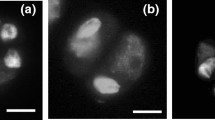Abstract
Two strains of Drosophila melanogaster represent the extremes in resistance and sensitivity to the lethal effects of CdCl2. The strain containing the mutations vermilion and brown (v; bw) and the strain Austin had LC50's of 3.3 and 1.3mm CdCl2, respectively. The three major chromosomes from these two strains were assorted genetically into the six possible combinations. The measured LC50's for CdCl2 for these six genotypes fell into two groups according to the X chromosome; those containing the X chromosome from v; bw had LC50's 0.5–1.0mm greater than those in which the X chromosome was from Austin. Since the parent strains differed by 2mm, we suggest that the X chromosome is a major, but not the sole, site of genes to produce resistance to CdCl2. When 109Cd was in the diet the uptake by v; bw and Austin over 2 days was the same. After 4 days of uptake, the Austin strain excreted the 109Cd five times faster than v; bw but the six genotypes did not differ appreciably in excretion rate from one another and resembled the sensitive parent Austin more than the resistant one. Thus a second process is indicated that distinguishes resistance to CdCl2 that apparently is not associated with the X chromosome.
Similar content being viewed by others
References
Ahrland, S., Chatt, J., and Davies, N. R. (1958). The relative affinities of ligand atoms for acceptor molecules and ions. Q. Rev. Chem. Soc. (Lond.) 12265.
Beach, L. R., and Palmiter, R. D. (1981). Amplification of the metallothionein-I gene in cadmium-resistant mouse cells. Proc. Natl. Acad. Sci. 782110.
Cherian, M. G., and Nordberg, M. (1983). Cellular adaption in metal toxicology and metallothionein. Toxicology 281.
Christie, N. T., and Costa, M. (1984). In vitro assessment of the toxicity of metal compounds. IV. Disposition of metals in cells: Interactions with membranes, glutathione, metallothionein, and DNA. Biol. Trace Element Res. 6139.
Christie, N. T., Gosslee, D. G., Bate, L. C., and Jacobson, K. B. (1983). Quantitative aspects of metal-ion content and toxicity in Drosophila. Toxicology 26295.
Cox, J. L., and Harrison, S. D., Jr. (1983). Correlation of metal toxicity with in vitro calmodulin inhibition. Biochem. Biophys. Res. Comm. 115106.
Hildebrand, C. E., Tobey, R. A., Campbell, E. W., and Enger, M. D. (1979). A cadmium-resistant variant of the Chinese hamster (CHO) cell with increased metallothionein induction capacity. Exp. Cell Res. 124237.
Jacobson, K. B., Opresko, L., Owenby, R. K., and Christie, N. T. (1981). Effects of cadmium on Drosophila; Toxicity, proteins, and transfer RNAs. Toxicol. Appl. Pharmacol. 60368.
Jones, M. M., and Vaughn, W. K. (1978). HSAB theory and acute metal ion toxicity and detoxification processes. J. Inorg. Nucl. Chem. 402081.
King, J. C., and Somme, L. (1958). Chromosomal analyses of the genetic factors for resistance to DDT in two resistant lines of Drosophila melanogaster. Genetics 43577.
Klaassen, C. D. (1978). Effect of metallothionein on hepatic disposition of metals. Am. J. Physiology 234E47.
Klaassen, C. D., and Wong, K. L. (1982). Cadmium toxicity in the newborn rat. Can. J. Physiol. Pharmacol. 601027.
Lindsley, D. L., and Grell, E. H. (1968). Genetic variations in Drosophila melanogaster. Carnegie Inst. Wash. Publ. No 627.
Maroni, G., and Dawson, D. (1984). Insect Biochem. (in press).
Pearson, R. G. (1963). Hard and soft acids and bases. J. Am. Chem. Soc. 853533.
Probst, G. S., Bousquet, W. F., and Miya, T. S. (1977). Correlation of hepatic metallothionein concentration with acute cadmium toxicity in the mouse. Toxicol. Appl. Pharmacol. 3961.
Rugstad, H. E., and Norseth, T. (1978). Cadmium resistance and content of cadmium-binding protein in two enzyme-deficient mutants of mouse fibroblasts (L-cells). Biochem. Pharmacol. 27647.
Statistical Analysis System (1978). SAS User's Guide SAS Institute, Raleigh, N.C.
Williams, M. W., Hoeschele, J. D., Turner, J. E., Jacobson, K. B., Christie, N. T., Paton, C. L., Smith, L. H., Witschi, H. R., and Lee, E. H. (1982). Chemical softness and acute metal toxicity in mice and Drosophila. Toxicol. Appl. Pharmacol. 63461.
Author information
Authors and Affiliations
Additional information
This research was sponsored by the Office of Health and Environmental Research, U.S. Department of Energy, under Contract DE-AC05-84OR21400 with Martin Marietta Energy Systems, Inc.
Rights and permissions
About this article
Cite this article
Christie, N.T., Williams, M.W. & Jacobson, K.B. Genetic and physiological parameters associated with cadmium toxicity in Drosophila melanogaster . Biochem Genet 23, 571–583 (1985). https://doi.org/10.1007/BF00504291
Received:
Revised:
Issue Date:
DOI: https://doi.org/10.1007/BF00504291




